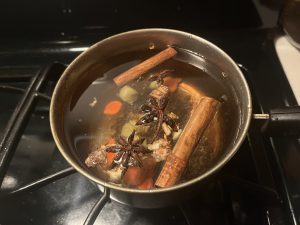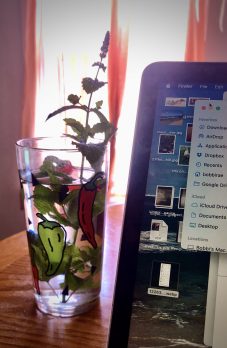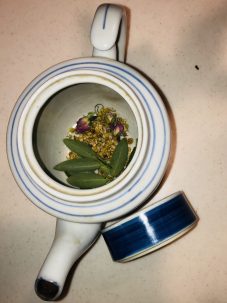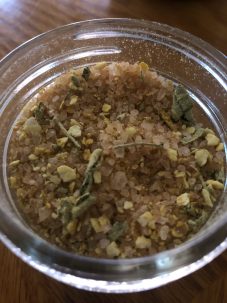Spice UP!
Culinary herbs and spices have been used for flavoring, as preservative agents, and for their medical properties for centuries.
Some of the widely known health effects attributed to herbs and spices include their ability to behave as antioxidants, anti-microbials, and anti-inflammatory agents, which give us protection from cardiovascular disease, neurodegeneration, type 2 diabetes, and cancer.
What real epidemics are we facing today? Heart disease still remains the #1 killer, while alzheimers and dementia are on the rise and getting a lot attention, diabetes in America as of 2020 1 in 10 people are clinically diabetic and 1 in 3 (!) people have pre-diabetes — this is sad. And cancer rates are not dropping, though some arms of the medical community are getting better able to treat it — still the side effects of the treatments hinder for a lifetime. Better to prevent.
There is rising interest in using culinary doses of herbs and spices as preventative medicine. A group of researchers have been systemically reviewing studies looking for biomarkers in humans that can be tested to see if using herbs and spices in foods — culinary only, not supplements makes a measurable difference — in other words; can the plant chemicals from the herbs we eat be measured in our biofluids (blood, urine, lymph, etc.)
This is a new form of testing called Biomarkers of Food Intake (BFIs). This is a better way of studying the effect of vegetables and herbs consumed and their benefits. Picó C et al “Biomarkers of Nutrition and Health: New Tools for New Approaches” Nutrients. 2019 May; 11(5): 1092. Published online 2019 May 16.
BFIs offer an accurate measure of intake, independent of the memory and sincerity of the subjects. Many studies are done with intake questionnaires asking people to remember their intake of foods over a certain period of time — sometimes even years. Not very accurate and many people tend to fill these out based on what they think they should be eating, not what they actually ate.
Note: Plant chemicals are phytochemicals (phyto = plant), they are naturally occurring in plants and offer humans immense benefits. I use both words interchangeably — plant chemicals or phytochemicals and even phytonutrients may slip in there every now and then.
And YES! They did find biomarkers they could measure from using culinary doses of herbs and spices. I had to laugh at the study though, they went on to try to determine which spice was responsible for which plant chemical in the bio fluids —but they could not determine which exact herb or spice supplied the specific phytochemical because many different herbs have the same plant chemicals just in differing percentages. As I was learning plant chemistry in relationship to aromatherapy I noticed many plants use the same plant phytochemicals in different percentages and combined with other varying phytochemicals. Which is why we can easily substitute one essential oil for another — for example birch and wintergreen are almost identical in their chemistry and can be interchanged easily.
For another example; take the phytochemical beta-carophyllene, it is a sesquiterpene that reduces anxiety (anxiolytic) and pain (analgesic) while being a powerful anti-inflammatory, and anti-microbial. It is in many different herbs which are not identical at all — from marijuana to frankincense, to cloves, hops, black pepper, and rosemary all have beta-caropyllene in some degree, and they all offer us those properties — reducing pain while calming and soothing to our nervous system, reducing inflammation and helping our body fend off harmful microbes.
But let’s NOT reduce plants powers to their individual phytochemical components. The power in plants and herbs is their combinations of many different phytochemicals. Modern medicine has been trying to do the same, get multiple actions in one single pill, but it can’t —it’s called polyvalence, plants have it and man can not figure out how to replicate it. Modern pharmaceuticals can only “safely” incorporate one phytochemical at a time without getting weird side effects.
Back to beta-carophyllene, beta-carophyllene is just one plant chemical in both frankincense and marijuana, those two plants have different benefits to the body based on what other plant chemicals the beta-carophyllene is combined with. If you extracted just the beta-carophyllene from either of those plants it’s benefit would be less effective without the other plant chemicals. One of the reasons I am not a big fan of supplements.
Using Frankincense again as an example, frankincense is known for its boswellic acids. However no boswellic acids are extracted in the process of distilling frankincense essential oil, yet the essential oil has many of the exact same benefits the boswellic acids offer in the resin form, even though it is not present. This clearly speaks to the fact that it’s the combination of all the plant chemicals that make the medicine.
Same for turmeric and curcumin, when you measure all the turmeric remaining that the curcumin as been extracted from it’s anti-inflammatory properties are still there — quite strongly I’d like to add.
We cannot isolate a plant’s benefits down to its individual components like modern medicine does. Truly the whole is greater than its parts.
Now that you understand that, we can get back to herbs and spices knowing their medicinal power lies in their complex array of many different phytochemicals.
The dried parts of plants add flavor and color to our dishes, keep our foods protected from microbial invaders that make us sick, while offering some impressive health benefits. Spices have been proven to both prevent and treat more than 100 different health conditions.
For example India has the lowest rate of dementia and neurodegeneration, this has been shown to be partly due to the culture’s high intake of turmeric through foods, and countries that traditionally use more spices have lower rates of cancer. For example they looked at basil, garlic, and oregano in Italian and Greek cuisines, lemongrass, ginger, cilantro, and chili peppers in Thai food, and curry spices in Indian foods.
Spices while small are mighty! Spices make up a small percentage of any meal you will eat with them, yet they offer more nutritional value than most carbs, proteins, and fats you will have on your plate — though those macronutrients are necessary for survival (well there is debate out there if carbs are necessary for survival). While the plants secondary metabolites, which are the active disease preventing mechanisms are not necessary for survival, they sure do make surviving easier and more pleasant.
Spices are powerful antioxidants (preventing aging and oxidation of our body’s tissues) packed with vitamins, minerals, and phytonutrients that help to keep our immune system robust. Spices also help us digest and absorb our foods, give us pleasant tastes and aromas and make our meal times more pleasant and enjoyable. But spices don’t just need to be part of just your meals — you can spice up your life all day long with a few tips, reaping immense benefit from increasing your phytonutrient intake.
Herbs are the leafy part of plants, and spices are the roots, buds, barks, stems, and  other sturdier parts of plants. Usually they are dried, but they can also be used fresh.
other sturdier parts of plants. Usually they are dried, but they can also be used fresh.
Leafy herbs and flowers are generally steeped, while more sturdy plant parts such as roots, stems, and barks are best boiled or concocted for 10 minutes to extract their medicines.
Here are some of the ways I spice up my life all day long:
- Water – In my water I always put a fresh herb, tulsi is one of my favorites, in the summer I like to add cooling herbs like peppermint or spearmint. I have to laugh … my daughter is recently all excited about this “new”

Spearmint from my garden in my water glass
product called Cold Infuse that is tea bags for plain drinking water to help you drink more water … as I shake my head and laugh I point to her my water glass saying “yea we’ve done that for millennia” only much cheaper, purer, and easier than paying $5.49 for 12 tea bags with a little herb, and stevia with other “natural flavors”. Why does everything have to be sweetened? We really have to break the sweet addictions. (Here are the ingredients: Red Hibiscus, Rosehips, Natural Strawberry, Watermelon And Mint Flavours With Other Natural Flavours, Beetroot, Natural Flavour (Steviol Glycosides), Orange Peel. -

My teapot: organic dried rose buds and chamomile flowers with fresh sage leaves from my garden.
Tea every night – Every evening its fun to walk in the garden and pick an herb to make tea with that night. Tea is a nightly ritual for me — I also collect and dry the herbs for use when the weather does not permit their growing. - Every morning I make a base brew of turmeric, ginger, and black pepper and add in various herbs or spices depending on the weather, season, and my mood.
- Cold winter day? Add lots of warming ginger and cinnamon to your tea.
- Hot summer day? Add cumin, coriander, and fennel to your tea.
- Fighting off a cold or been around someone who’s sick? Add turmeric, ginger, and echinacea powder, black pepper, or hyssop leaves to your tea.
- Have a little extra phlegm in your lungs? Make a tea with cardamom, anise seed, cinnamon, and a pinch of licorice root. Take few sips and feel how those herbs are effective expectorants.
- Smoothies or dairy drinks — adding cinnamon, cardamom, and nutmeg boost to smoothies and milk or dairy drinks. Cinnamon is known to help regulate blood sugar and blood pressure, so if you are indulging in ice cream or a blood sugar wrecking cake or sweet, sprinkling it with cinnamon may help to dissipate the side effects while giving you a boost of anti-microbials.
- Nutmeg is an interesting herb to experiment with, it has a mildly psychotropic effect — relaxing your mind and your emotions reducing anxiety, it is slightly warming and also has aphrodisiac properties, it helps us fall asleep so it makes for a nice evening herb.
- I like to diffuse nutmeg, ylang ylang, and sweet orange during times someone is experience anxiety or just any evening to help relax and unwind.
- Cooking spices and churnas – Keep a bottle of mixed cooking spices (known as churnas in India) close to your stove, every time you turn on the skillet add a little oil and a dusting of your spice mixture. I like the ayurvedic churnas that are specific for each season — there are vata churnas, pitta churnas, kapha churnas, and tridoshic churnas for days when I don’t know which churna I need! You can do the same with any spice blend, like herbs de Provence, Mexican herb and spice blends, or Italian or Greek spice blends.
- These add a lot of good flavor to your foods and are the secret ingredients of many tasty dishes. I have turned so many people onto my cooked cabbage recipe because of the flavorful spices I put in it.
- Pestos! I am a big pesto fan, at any given time I will have 1-3 different herbal pestos in my fridge and/or freezer. You can make pesto with more than just basil, for example cilantro makes an amazing pesto, as does watercress, fennel, dill, a combination of herbs, and even spinach, broccoli or avocado. Here are the search results showing 16 different pestos in my learn & thrive section — all of which I make often.
- Finishing Salts – I add dried herbs to my salts and make

Dried Maui orange peel, dried sage from my garden, in aalea salt.
flavorful finishing salts. Dried rosemary in black lava salt is one of my favorites, I also like dried lime peel in sea salt, and dried sage and orange peel in aalea salt. - Between your cheek and gums … I often tuck a clove bud in between my cheek and gums while teaching or out shopping — and especially during the covid fiasco as clove is a powerful anti-viral and anti-microbial in general. And it happens to be good for your teeth 🙂 I think my habit of chewing on clove buds while teaching and assisting lots of different bodies kept me from getting many colds and flus that other teachers seemed to get more often.
- Salads and Sandwiches — Mustard is a powerhouse herb which greatly boosts our immune function. Chives and basil are delicious in sandwiches and salads, I love infusing oregano in olive oil for salad dressings.
- Condiments — Mustard and ketchup add a lot of spices to our foods, mustard usually contains turmeric so you can get a little more turmeric in your life through condiments. Horseradish is delicious in ketchup, and adds a powerful chest clearing kick. You can add freshly grated garlic and pepper to mayo to spice up your mayo.
- Meats – you can marinate meats in spices. Turmeric is commonly used, as well as curries to put on meats. I love rosemary and garlic tucked under the skin of chicken.
- Furthermore studies show the harmful effects of eating meat are neutralized when consumed along with lots of spices and varying phytonutrients.
- Fish – dill on fish is delicious. I also often do cilantro pesto on fish, not only is it tasty, the cilantro also helps you detox mercury which collects in fish.
- Vegetables — try adding ginger to cooked vegetables, try dill in cabbage based foods, try rosemary in root vegetables, and get in the habit of taking a walk in your herb garden when you are making salads — I like to toss in nasturtium leaves and flowers, chive flowers, chives, or whatever herb is growing in abundance.
- Eggs – I love my churnas in my eggs, every egg I fry starts with churnas in coconut oil and butter. Parsley and chives are also good in eggs.
- Grains – I love adding cardamom or saffron to rice, oregano and rosemary or basil to pastas. Sage is delicious in rice and lentils.
Studies show that even a single fast-food meal harms blood vessels. But, much of the adverse effects can be offset by consuming phytonutrients and antioxidants — spices and herbs found in colorful, nutrient-dense plant foods. Mark Hyman, MD stated in his Longevity Roadmap series “It may very well be the absence of medicinal phytochemicals and antioxidants that is driving many diseases”. Eating a nutrient-dense, whole foods diet, rich in phytonutrients, helps prevent the damage in the first place.
How many phytonutrients can you get in your day?
Experiment! Spices are good for your body and mind, and boost overall immune and health quality. They tickle our senses and awaken our taste buds.
